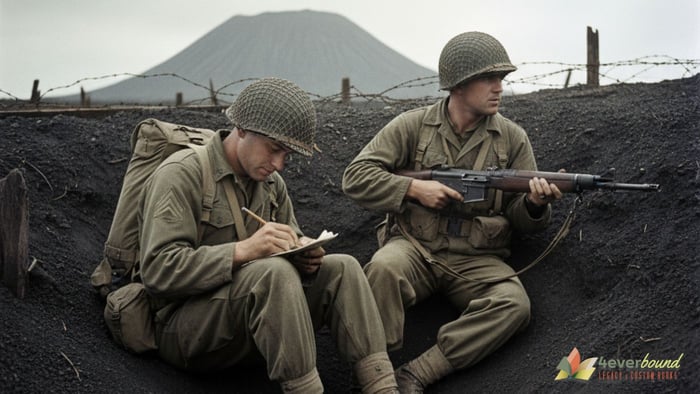Table of Contents
- Table of Contents
- The Foxhole: A Marine's Temporary Home on Iwo Jima
- Writing Materials: What Did Marines Use in Combat?
- Weather and Conditions: The Challenge of the Elements
- The Daily Routine of Combat Correspondence
- The Psychological Courage Behind Every Letter
- The Miracle of Mail Delivery from Combat Zones
- Why These Letters Matter: Preserving History's Most Personal Moments
- The Legacy of Combat Correspondence
- Combat Writing Challenges: A Comprehensive Breakdown
- Professional Vintage War Letter Preservation Services
Preserving Vintage War Letters: The Reality Behind Writing Letters from the Foxholes at Iwo Jima
Table of Contents
- The Foxhole: A Marine's Temporary Home
- Writing Materials: What Did Marines Use?
- Weather and Conditions
- Daily Routine of Combat Correspondence
- Psychological Courage Behind Every Letter
- Mail Delivery from Combat Zones
- Why These Letters Matter
- Professional Preservation Services
The ink-stained pages of wartime correspondence tell stories that history books simply cannot capture. As we specialize in preserving vintage war letters, we're preparing to preserve a remarkable collection of letters written by a US Marine during the brutal 36-day Battle of Iwo Jima. This project has us contemplating an extraordinary reality: how did soldiers manage to write intimate letters to their loved ones while literally fighting for their lives in foxholes?
These weren't letters penned in comfortable quarters behind the lines. These were desperate communications scratched out between artillery barrages, written on whatever scraps of paper could be found, and somehow delivered across 6,000 miles of Pacific Ocean to anxious families back home.
The Foxhole: A Marine's Temporary Home on Iwo Jima
Understanding the context of these letters begins with understanding the foxhole itself. On Iwo Jima's black volcanic sand, a typical Marine foxhole was a shallow depression barely three feet deep and just wide enough for two men to crouch side by side. The island's unique volcanic ash made digging incredibly difficult – it was like trying to excavate loose charcoal that constantly caved in on itself.
Most foxholes housed two Marines, following the buddy system that provided both tactical advantage and psychological comfort. These cramped spaces, measuring roughly six feet long by three feet wide, became home, fortress, and writing desk all at once. The men would take turns on watch while the other attempted to rest, eat, or in precious quiet moments, write letters home.
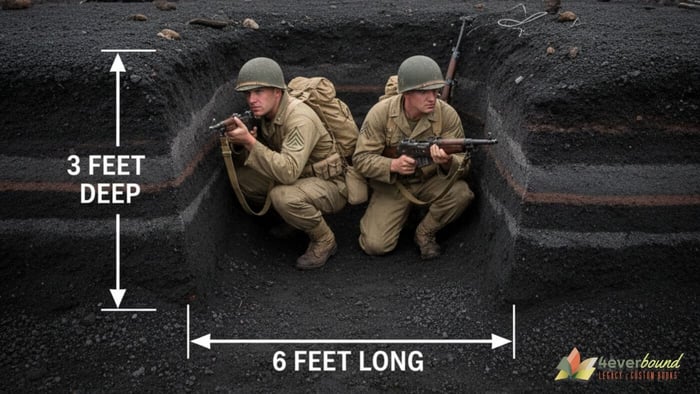
The volcanic soil provided some protection from shrapnel, but it also created unique challenges. The black sand got into everything – uniforms, weapons, food, and certainly the precious writing materials that connected these young men to home. Perhaps most overwhelming was the pervasive smell of sulfur that reeked from the volcanic landscape, permeating everything including clothing, food, and the very paper on which letters were written. This acrid odor became an inescapable part of daily existence, clinging to every aspect of life in the foxholes.
Adding to these challenges was Iwo Jima's critical water shortage. The island had no natural fresh water sources, forcing Marines to rely on captured Japanese rainwater cisterns and inadequate desalination units that couldn't meet demand. The constant state of thirst and strict water rationing dominated daily life, making even basic hygiene a luxury. A single canteen became precious beyond measure, and the rare opportunity to wash with helmet water was considered extraordinary fortune.
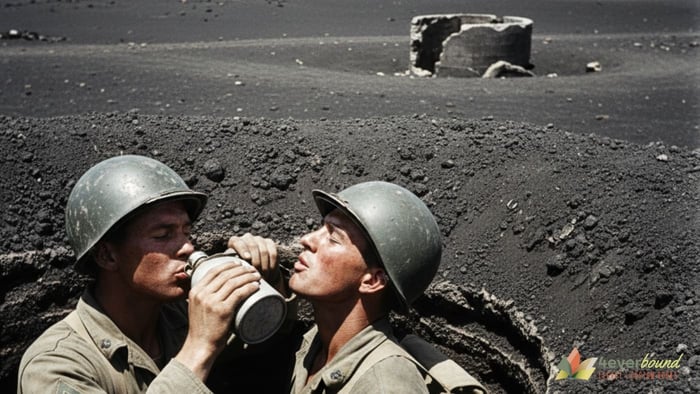
Writing Materials: What Did Marines Use in Combat?
Marine combat soldiers didn't have the luxury of a well-stocked writing desk. Most carried standard-issue writing materials in their packs: a small tablet of writing paper, a few envelopes, and a pencil or pen if they were fortunate. Many letters from Iwo Jima were written on whatever paper was available – pages torn from field manuals, the backs of military forms, or even cigarette packages flattened out.
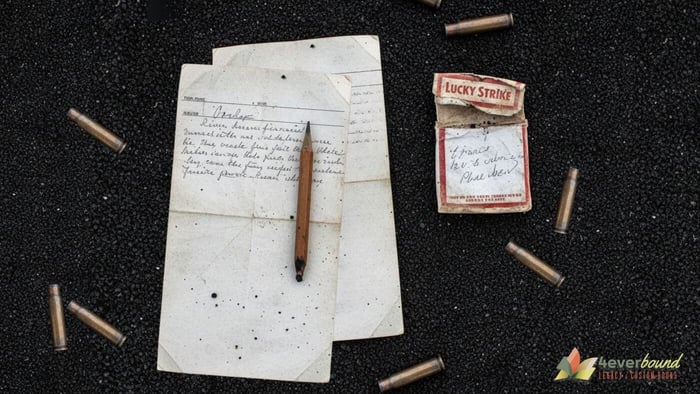
The Marine in our upcoming collection somehow managed to write daily, which suggests either remarkable foresight in packing writing supplies or resourcefulness in finding materials. V-mail (Victory Mail) forms were popular because they were lightweight and designed specifically for overseas correspondence, though many Marines preferred regular stationery for longer, more personal messages.
Pencils were generally preferred over pens in combat zones because they worked better in extreme conditions and didn't freeze or dry out. The graphite also wouldn't run if the paper got wet – a constant concern in the foxholes of Iwo Jima. When preserving vintage war letters, we often encounter these pencil-written documents that have survived decades better than their ink counterparts. Learn about our letter scanning services that carefully handle these delicate wartime materials.
Weather and Conditions: The Challenge of the Elements
February and March 1945 on Iwo Jima presented brutal conditions for letter writing. Daytime temperatures reached into the 80s, but nights could drop dramatically, creating condensation that soaked everything. The volcanic ash created a fine dust that coated every surface, including precious writing paper.
Rain was sporadic but devastating when it came. Water would pool in the foxholes, turning the volcanic ash into what Marines described as a thick, gluey black sludge that stuck to everything and coated all equipment. Marines had to protect their letters and writing materials in waterproof pouches or wrapped in ponchos. Many letters from this period show water stains, mud spots, or smudged ink – physical evidence of the conditions under which they were written.
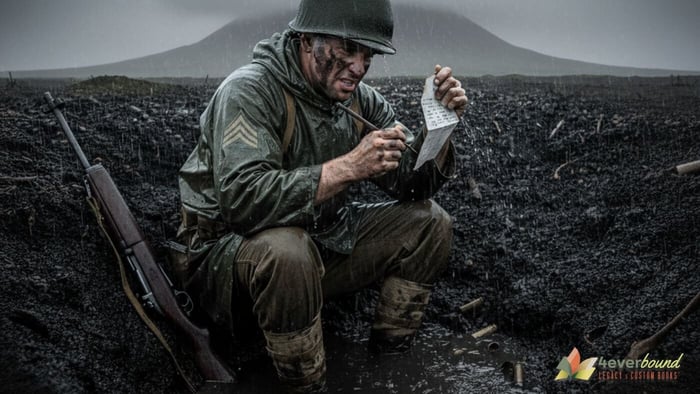
The constant artillery bombardment created additional challenges. Writing during daylight hours was extremely dangerous, as any movement could draw sniper fire. Most personal correspondence was written during brief lulls in fighting or in the dark hours before dawn, when exhausted Marines would scratch out a few precious lines by feel or the dim glow of carefully concealed light.
But even darkness brought no true safety. Japanese forces utilized extensive tunnel networks for nightly infiltration, emerging to attack foxholes under cover of darkness. To prevent friendly fire incidents during these tense nighttime hours, Marines used a system of daily changing passwords. This constant threat meant that even while writing letters in supposed quiet moments, Marines remained in a state of nerve-wracking vigilance, listening for any sound that might signal an approaching enemy.
The Daily Routine of Combat Correspondence
For a Marine to write daily letters during the Battle of Iwo Jima demonstrates extraordinary dedication to maintaining connection with home. The routine likely went something like this: during the relative quiet of early morning, before the day's fighting intensified, a Marine might pull out a crumpled piece of paper and a stub of a pencil. Or, he might take advantage of the free illumination from the moon.
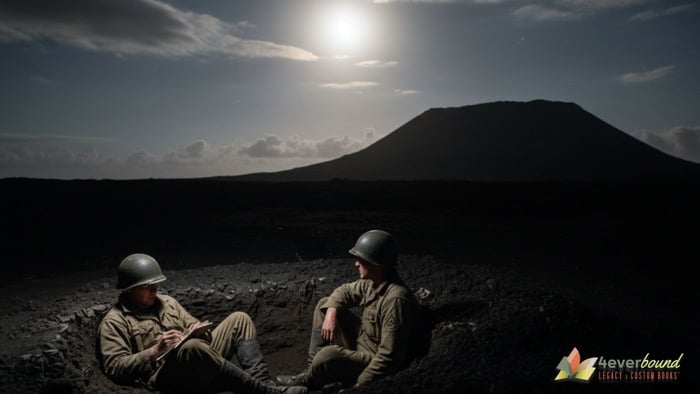
Sitting in the cramped foxhole, back pressed against the volcanic earth, he would balance the paper on his knee or helmet and write quickly. The letters had to be brief – not just because of space limitations, but because extended writing sessions increased the risk of detection by enemy snipers who watched for any sign of movement.
Writing a letter under these conditions was an act of defiance against overwhelming circumstances. The immense combat stress, constant shelling, and witnessing death created a psychological burden that made composing coherent thoughts incredibly difficult. The sheer mental exhaustion from maintaining constant vigilance would have made the simple act of forming letters on paper feel monumental.
The content of these letters was carefully self-censored, driven not only by military regulations but by a protective instinct toward families back home. Marines deliberately shielded their loved ones from the horrific reality they faced daily. Rather than describing the sulfurous air, the thirst, the terror of nighttime infiltrations, or the sight of fallen comrades, they focused on reassurances, expressions of longing for home, and sometimes subtle hints about their conditions that families would learn to decode over time.
The Psychological Courage Behind Every Letter
Beyond the physical challenges of writing in combat conditions lay an even greater test: the psychological fortitude required to maintain hope and connection while surrounded by unimaginable brutality. The Marines fighting on Iwo Jima endured constant artillery bombardment, witnessed the deaths of close friends, and lived in a state of perpetual terror that few can comprehend.
Under such extreme combat stress, the simple act of writing "I am well" or "Don't worry about me" represented profound mental strength. These men had to compartmentalize their trauma sufficiently to craft messages that would comfort rather than alarm their families. The letters required them to reach beyond their immediate reality of sulfurous air, chronic thirst, sleepless nights, and ever-present death to connect with a world of normalcy they could barely remember.
Each letter was simultaneously an escape from the horror and a lifeline to sanity. In focusing on memories of home, expressions of love, and plans for the future, these Marines performed daily acts of psychological survival that were as crucial as their physical endurance in the foxholes. Understanding this psychological context is essential when preserving vintage war letters, as it helps us appreciate the true depth of what these documents represent.
The Miracle of Mail Delivery from Combat Zones
Perhaps the most remarkable aspect of these foxhole letters is that they reached their destinations at all. The military postal system during World War II was an incredible logistical achievement that somehow managed to connect the most remote combat zones with hometown America.
Letters written in Iwo Jima foxholes would be collected during supply runs or when units rotated back from the front lines. They were then transported to beach collection points, loaded onto supply ships, and began their long journey across the Pacific. The entire process typically took two to three weeks, though some letters took months to arrive.
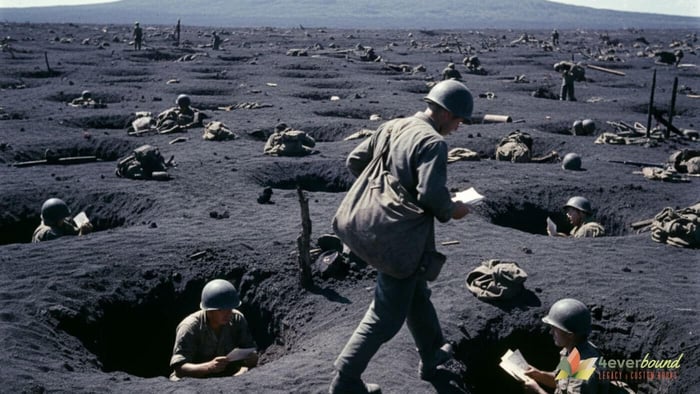
The fact that families received regular correspondence from Marines fighting one of the Pacific War's bloodiest battles represents both the dedication of individual soldiers to maintain these connections and the military's recognition that mail was essential for morale.
Why These Letters Matter: Preserving History's Most Personal Moments
As we prepare to digitally preserve and analyze this collection of Iwo Jima letters, we're reminded that preserving vintage war letters involves more than just handling historical documents – we're preserving the most intimate thoughts of a young man fighting for his life in one of history's most brutal battles.
These letters offer something that official military histories cannot: the immediate, unfiltered emotional reality of combat. They capture not just what happened, but how it felt to happen. They preserve the voice of a generation that paid the ultimate price for freedom, written in their own words, in their own moment of crisis.
Every smudge of volcanic ash, every water stain, every hurried scrawl tells part of the story. When we scan these letters and create historical narratives from their contents, we're building bridges between that foxhole on a remote Pacific island and the families who waited anxiously for news from the front. See examples of our WWII letter preservation projects to understand how we transform these fragile documents into lasting legacies.
The Legacy of Combat Correspondence
The practice of writing letters from combat zones wasn't unique to Iwo Jima, but the intensity and duration of that battle made such correspondence particularly precious. These letters became lifelines – not just for the families who received them, but for the Marines who wrote them. In the act of writing, they maintained their connection to the world they were fighting to preserve.
Today, as we prepare to transform these fragile pieces of paper into lasting digital archives and printed books, we carry forward that same mission of connection. Our expertise in preserving vintage war letters ensures that the voices from those foxholes continue to speak to future generations, telling their stories of courage, fear, love, and sacrifice in their own words.
The Marines who wrote from Iwo Jima's foxholes left us more than historical records – they left us their humanity, preserved in ink and pencil on paper that survived one of history's most terrible battles. Our job is to ensure these voices are never forgotten.
Combat Writing Challenges: A Comprehensive Breakdown
Understanding the complexity of writing letters from foxholes requires examining multiple factors that affected every aspect of the process:
Environmental Factors
- Sulfur contamination: Volcanic gases permeated all materials
- Water scarcity: Critical shortage affecting basic survival
- Temperature extremes: 80°F days, dramatic nighttime drops
- Volcanic ash: Created gluey black sludge when wet
Tactical Constraints
- Daylight writing: Extremely dangerous due to sniper detection
- Night infiltration: Japanese tunnel networks posed constant threat
- Password systems: Daily changing codes prevented friendly fire
- Limited time windows: Brief dawn/dusk opportunities only
Psychological Pressures
- Combat stress: Constant artillery and death witnessing
- Self-censorship: Protecting families from horrific realities
- Mental exhaustion: Vigilance requirements affected cognitive function
- Compartmentalization: Need to shift between survival and communication modes
Professional Vintage War Letter Preservation Services
Preserving vintage war letters requires specialized expertise and understanding of the unique challenges these documents faced. From volcanic ash contamination to water damage, from hurried handwriting to fading ink, each letter presents its own preservation challenges that demand professional care and historical knowledge.
Whether your family has letters from the Pacific Theater, European campaigns, or other military conflicts, these documents represent irreplaceable pieces of personal and national history. The process of preserving vintage war letters involves careful digitization, historical research, and often the creation of beautiful printed books that can be shared with family members and future generations.
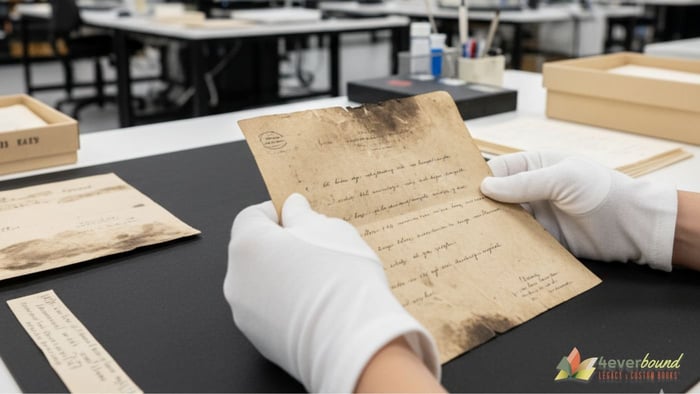
Do you have vintage war letters that need professional preservation? Our team specializes in preserving vintage war letters, digitally scanning, historically analyzing, and creating beautiful printed books from wartime correspondence. Whether you have letters from Iwo Jima, D-Day, the Korean War, or Vietnam, we understand the unique challenges of preserving vintage war letters and military documents. Contact us for military document preservation to learn how we can help preserve your family's piece of history and ensure these precious voices continue to be heard.



